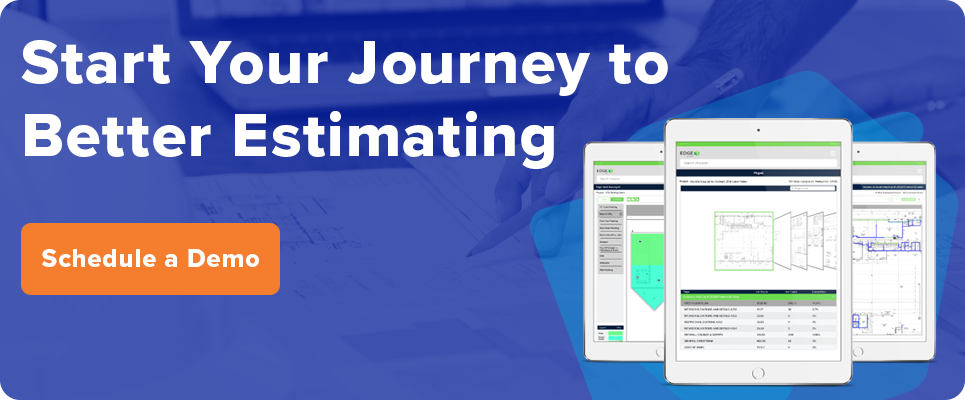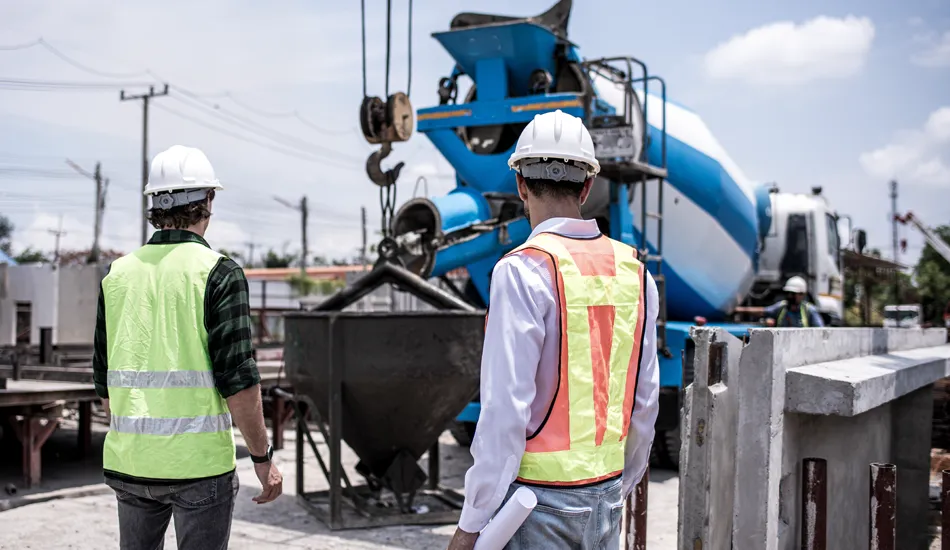
Roofing estimators are a specialized group that help ensure the success of commercial roofing projects. They act as the project’s financial backbone by meticulously calculating the materials, labor, time and overall costs involved in installing or repairing commercial roofs.
But what makes a roofing estimator successful? Truthfully, there are quite a few habits that define good estimating. One recent trend in particular is using estimating software. According to a recent study by Roofer Digest, around 57% of roofing professionals leverage such software to deliver quotes faster.

And that’s just one common habit. Whether you’re a newer roofing professional looking to refine your estimating skills or a seasoned roofing estimator ready to better understand the process, let’s walk through what makes a successful roofing estimator.
Key Takeaways for Roofing Estimators:
- What makes a successful estimator is a deep understanding of various commercial roofing systems and their material costs, installation complexities and labor requirements.
- Successful roofing estimators consider the complexity of the project, plan for additional costs, work with other experts for accurate bid proposals, know how to navigate roofing estimating software and breakdown contingencies in their estimates.
- Regularly review and evaluate past estimates compared to actual project costs to identify areas for improvement and ensure your estimates are as accurate as possible.
- Roofing estimating software offers advanced takeoff capabilities, material calculations, advanced cost estimating features and real-time collaboration for estimators.
- Using roofing estimating software to simplify the process can improve the accuracy of roofing estimates and generate estimates quickly.
What Makes a Successful Roofing Estimate?
Commercial roofing estimators are detail-oriented analysts, but just like anything else, they’re not all created equal. What makes an estimator successful is a deep understanding of various commercial roofing systems and their material costs, installation complexities and labor requirements.
This expertise allows estimators to create highly accurate estimates that help roofing companies plan timelines efficiently, submit competitive bids and help ensure projects stay within budget and are completed on schedule. Here is a deep dive into these various considerations so you can see their impact on successful estimating.
1. Project Scale and Complexity
Commercial roofs are typically much larger and have intricate measurements compared to noncommercial roofing projects. Which means commercial roofing estimating requires advanced takeoff skills to accurately calculate material quantities for irregular shapes like curbs, drains and skylights.
These complexities extend beyond just measurements. Understanding the specific roofing system involved in the project scope, whether it’s a flat roof, metal roof or another system, is also important. Successful roofing estimators need to be familiar with the unique materials and installation requirements of each system to ensure they include the right resources in the estimate. This knowledge also helps them identify the best suppliers for quality materials at competitive prices, and factor in realistic timelines for completing the project based on the complexity of the roof system.
2. Cost Considerations
Beyond materials and labor, successful roofing estimators must consider additional costs that require careful calculations, including:
- Tear-offs of existing roofs
- Permits
- Safety measures for large crews
- Potential disruptions to ongoing building operations
By accounting for these expenses in the original estimates, the outlined budgets are far more accurate.
Additionally, environmental considerations are playing a bigger role in today’s construction landscape, and more roofing estimators are beginning to factor in sustainable materials and energy-efficient designs into their calculations.
3. Bid Proposal Compromises
Successful roofing estimators will work closely with building managers, architects and facility owners. Each role will have different priorities and budget constraints depending on the complexity of the project. This may require the estimator to find compromises within the project, so the parties involved are left satisfied.
For example, an owner may need to make changes to the project. This may require an estimator to create a more detailed bid proposal that includes specifications, warranty information and references with all these additional costs must be reflected in the estimate. A successful estimator will accomplish that while ensuring the architect still finds the project feasible and the building manager still verifies everything is up to code.
4. Leveraging Software
Roofing takeoff and estimating software plays a major role in successful roofing estimating as most come with features for complex roofing calculations like wind load analysis and factoring in multiple material layers for flat roofs. Successful roofing estimators have the expertise to navigate roofing contractor software while staying updated on industry trends, new materials and safety regulations specific to roofing projects.
5. Risk Management
Successful commercial roofing estimators anticipate potential risks like weather delays or equipment breakdowns within their estimates. They recognize that being ready to adjust strategies within the estimate protects both the client and the roofing company.
Finding cost-saving opportunities for these potential risks without compromising on quality or safety is important and may involve proposing alternative materials or installation methods in the estimate.
What Are the Best Practices for Roofing Estimators?
Roofing estimating is extremely complex, but following these best practices can help you be successful.
Before the Estimate
Conduct a detailed inspection of the roof, including measurements, identifying potential problems like leaks or weak areas and assessing the condition of the existing roofing system.
Take time to understand the client’s specific needs and requirements, such as the desired timeline and any special requests to ensure your estimate is tailored to their situation.
Creating the Estimate
Include accurate pricing for materials and labor in your estimates. Get quotes from multiple suppliers to secure the best prices. Break down costs by category for transparent client communication and always factor in contingencies for unforeseen circumstances to strengthen the estimate’s credibility.
Project Management Throughout the Estimating Process
Estimators and project managers should collaborate on estimates and proposals in real time to improve efficiency and communication. A project manager can provide valuable insights as they have a deep understanding of the project’s overall design, timeline and potential challenges.
By collaborating in real-time, they can share crucial details that might not be readily apparent from the roof plans like accessibility limitations due to existing building features or potential sequencing issues with other trades.
With their expertise, you can generate reports to analyze past estimates compared to actual project costs. This helps identify areas for improvement and ensures future estimates are as accurate as possible.
After the Estimate is Complete
Keep detailed records of all estimates, including the scope of work, materials used, labor costs and any contingencies as referencing past estimates can help you improve future ones. With that, regularly review and evaluate past estimates compared to actual project costs to identify areas for improvement and ensure your estimates are as accurate as possible.
What Construction Software Do Successful Roofing Estimators Use?
Commercial roofing estimators need estimating software that tackles the specific challenges of their field. Here are some key features an estimator would look for in roofing takeoff and estimating software:
1. Advanced Construction Takeoff Capabilities
The software should allow for takeoff calculations for roofing measurements to be uploaded or directly captured through the program. This eliminates manual measuring errors and streamlines the takeoff process.
- Additionally, the software should be able to handle measurements for complex roof shapes for precise material estimates.
- The software should also be able to handle projects with multiple roof planes.
2. Material Pricing
The software should offer pre-loaded trade-specific databases with various commercial roofing systems and their material components to save time and improve accuracy.
The software should include integration with real-time material calculations databases or the ability to import supplier quotes to ensure estimates reflect current market costs. The software should account for material waste during installation, providing a more realistic estimate of materials needed.
3. Detailed Commercial Cost Calculations
If the software offers advanced cost estimating features like pre-populated databases with commercial roofing labor rates, this can streamline the estimating process greatly.
- Cost estimating software should also be ableto generate detailed Cost Breakdown Structure (CBS) reports that label costs by category.
- Any software with a contingency planning toolfor unforeseen circumstances can strengthen the estimate’s credibility.
4. Scalability
As a roofing business grows, project complexity often increases. Beyond the initial estimate for material and labor, roofing estimators need to handle factors like tear-offs, permits and intricate roof designs. A scalable estimating software is crucial for keeping pace with this growth.
Cloud-based estimating software can adapt to handle larger projects with more elements, allowing estimators to continue creating detailed and accurate estimates. This not only saves time but also minimizes errors and ensures estimates remain competitive. Scalable estimating software can empower roofing estimators to efficiently handle the increasing demands of the construction industry.
Additional Software Considerations
- Compare Past Estimates: Most takeoff and estimating software for roofers also offers reporting features that analyze past estimates compared to actual project costs to identify areas for improvement.
- Ease of Use: An estimating software with an intuitive digital interface that is easy to navigate can help build estimates faster with reduced data entry and a streamlined workflow.
- Mobile Compatibility: The ability to access and update estimates on mobile devices allows for flexibility and on-site adjustments while allowing people to work from anywhere without internet access.
- Integration: The ability to seamlessly integrate with other construction software can help streamline the labor cost calculation and material list generation process. With integration into your accounting software, you can easily transfer data between the systems for reduced manual entry and improved budget control.
See How The EDGE® Can Simplify the Roofing Estimating Process
Roofing estimating can be a complicated process, but knowing what makes a successful roofing estimate, the best practices for roofing estimating and how to leverage tools like roofing estimating and takeoff software can help you refine the process. Roofing estimators face different requirements, which can often make it difficult to estimate efficiently. Using software to simplify the process can improve the accuracy of roofing estimates and generate estimates quickly.

And if you work in the roofing trade, consider using The EDGE. We offer trade-specific, customizable databases in construction estimating and digital takeoff that have helped thousands of estimators create accurate bids.
Contact us today to book a demo with one of our construction estimating experts!






